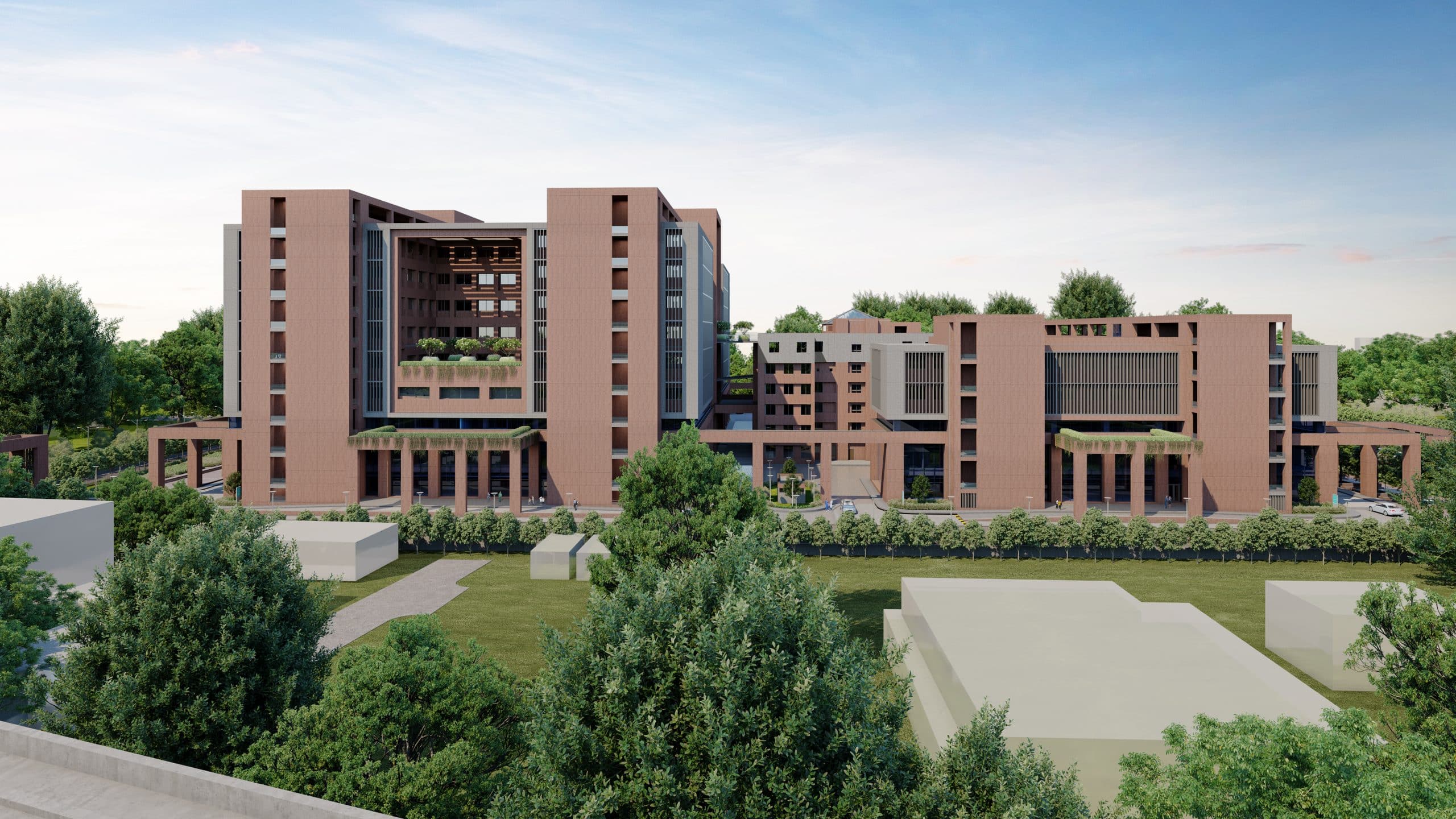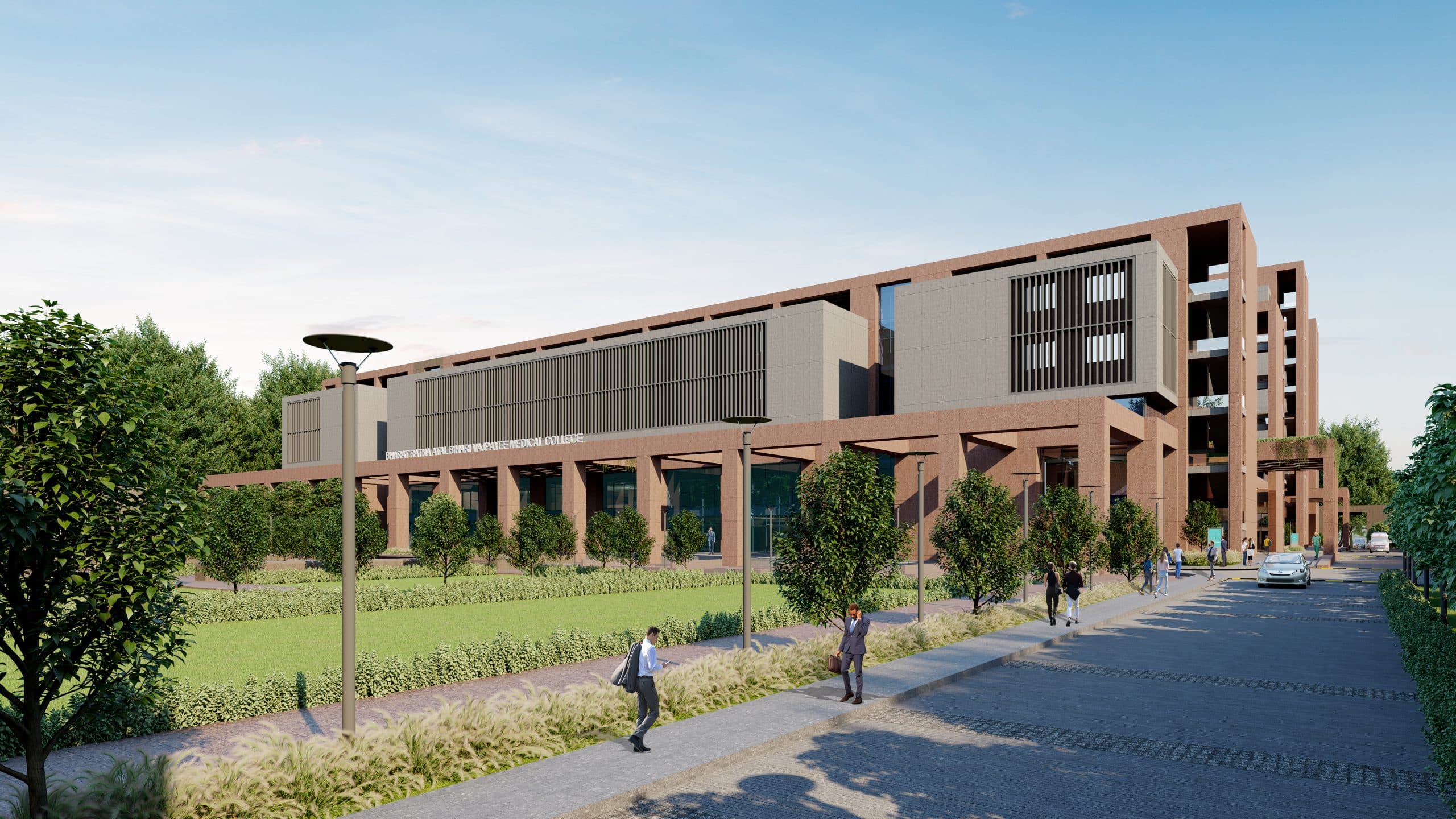
Atal Bihari Vajpayee Institute of Medicine
Pune, Maharashtra, India
Benchmark Civic Healthcare Facility & Learning Campus
This civic hospital and medical education campus is envisioned by the
Pune Municipal Corporation with the intent of establishing its identity as
the guardian of the city’s health. The proposed site in the heart of the
city, at close proximity to landmarks like the river front and
infrastructure like the rail and metro stations, belonged to an existing
infectious diseases hospital. The larger site was also bounded by
proposed DP roads in addition to the existing main road access, out of
which a major southern part and an additional smaller portion across a
DP road were allocated for this civic medical campus.
INI’s design weaves around the existing infectious diseases hospital
facility at the center after removing the other smaller, inadequately
efficient existing structures and road front encroachments. The Master
Plan integrates three newly built zones that are assigned to each of
three clear campus parts – a teaching hospital facility to deliver
multi-specialty health care, a college for multi departmental medical
education on the larger site, and residential accommodation for staff
and students on the smaller land parcel.
Site Area : 12 Acres
Builtup Area : 11,00,000 SF Approx.
Services : Feasibility Study, Medical & Laboratory Programing & Planning, Architecture, Engineering, Interior Design, FFE, Lighting Design, AV, Acoustics, Environmental Graphics & Signage, Kitchen & Laundry Design, Lab & Medical Gases, Landscape Design, HR, HIS, PMC Support, Sustainability
Accolade : IGBC Gold Certification
14th Realty+ Conclave & Excellence Awards, Gujarat – 2022 (Architectural Firm of The Year)
Share ►

Efficacious Functional Zoning, Internal Circulation, External Mobility
The campus planning allows for smooth and efficient flow of men, material and services. It has a western front with entry/ exit points gained from the 30 m wide DP road, and an eastern landscaped rear opening on to an 18 m wide DP road. These multiple and distinct entry/ exit points coupled with peripheral roads and pedestrian paths looping around the hospital and college zones make public as well as employee way-finding and mobility highly convenient and efficient. Lateral entry and exit points provided from northern and southern sides give access to both hospital and college buildings from the common central quadrangle, where emergency access to the trauma care center and the existing infectious disease hospital is also made instantly available immediately.


As an impressive frontal landscaped portal adorned with Shri Vajpayee’s statue leads on to the internal path shaded by colonnades and pergolas, the hospital building can be entered across from it Ample parking is made available in the hospital building basement, out-patient facilities occupy the lower floors and inpatient and procedural facilities are housed in the upper floors of the ground plus eight floor structure. Coordinated departmental lecture halls, labs, clinics, library and auditorium facilities have been meticulously designed in the ground plus five story college building. The buildings have twin central circulation cores from which twin mutually parallel passages branch out into the northern and southern wings leading clearly towards individual departments.


Climate Responsive Regionally Contextual Form & Facade
While a delicately articulated massing of simple but elegant forms defines a minimalist aesthetic which is contextually rooted in the regional modernist architecture native to post Independence India, the materiality comprising local stone cladding as well as terracotta fins reinforces this nativity. The use of colonnades with pergolas on the lowest levels of the facades for shading the buildings and the pathways, fins on the higher levels to cut out glare and heat while optimizing daylight for the interiors, use of external staircases encased in screening walls at the ends of the building’s wings as a means to insulate from harsh heat, green terraces shaded by pergolas carving out voids which act as ventilating vertical courtyards between the hospital’s parallel wings, a taller built form located on the western front shading the shorter building behind it as well as the plaza between them – all these elements constitute the body of climate responsive passive strategies used in the building’s architecture. Besides, many active devices for energy, water and waste disposal efficiency such as roof-top solar PV panels, rainwater harvesting, grey water recycling, etc. have been incorporated to contribute to the campus’ sustainability at platinum level certification.

“Responsible Planning & Locally Contextual Architecture for Civic Healthcare & Education Design.”

